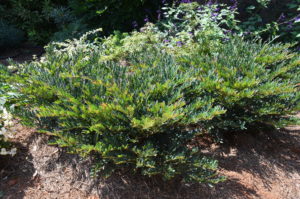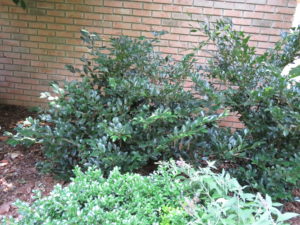Distyliums (Distylium x), aka Isu tree, are being billed as “the best new plants you’ve never heard of”. Get accustomed to seeing these boxwood-like shrubs in local garden centers, e.g., if you live within USDA hardiness zones 6b-9. Distyliums are the result of selective breeding efforts to improve an evergreen shrub native to China at elevations above 3000 feet.
Hybrid distyliums are heat and drought tolerant and cope with wet soils. Their foliage is highly disease and insect resistant. They are an excellent replacements for those evergreen shrubs susceptible to one or more disease and pest problems. Examples include euonymus (Euonymus fortunei), cherry laurels (Prunus laurocerasus), junipers (Juniperus spp.), hollies (Ilex spp.), and Indian hawthorn (Rhaphiolepis spp.).
Distyliums perform best in full to partial sunlight and in moist well-drained soil. Shrubs thrives in moist, well-drained, slightly acidic soil; do not plant on poorly drained site. Keep plants mulched for a mostly weed-free planting and to conserve soil moisture. Feed with a slow release fertilizer such as Osmocote® or Nutrikote® at the start of spring. Prune after flowering to size and shape shrub.
These five cultivars are all hybrids (D. myricoides × D. racemosum):
Vintage Jade® grows in an arching mounding form low and spreading at 2-3 feet high and 5 feet wide, ideal low hedges and borders along walkways or paths.
Cinnamon Girl® has bronze foliage at 3 feet tall and 5 feet width. plum-purple new growth which turns blue-green as the leaves and mature to blue green.
Blue Cascade® grows slightly upright at 3 feet high and 4 feet wide with dusty bluish cast to the foliage.
Emerald Heights® has dark green glossy foliage and slightly upright form at 5 feet high and wide.
Coppertone® 3-4 feet evergreen shrub with a rounded to spreading habit. New leaves are coppery red mature to blue green.
Distyliums belong to the witchhazel family (Hamamelidaceae). Small, reddish maroon flowers bloom in March and go pretty much without notice. They make wonderful foundation, screening and hedging shrubs in almost any landscape. Add them to mixed plantings in large containers.



 Posted in
Posted in 
